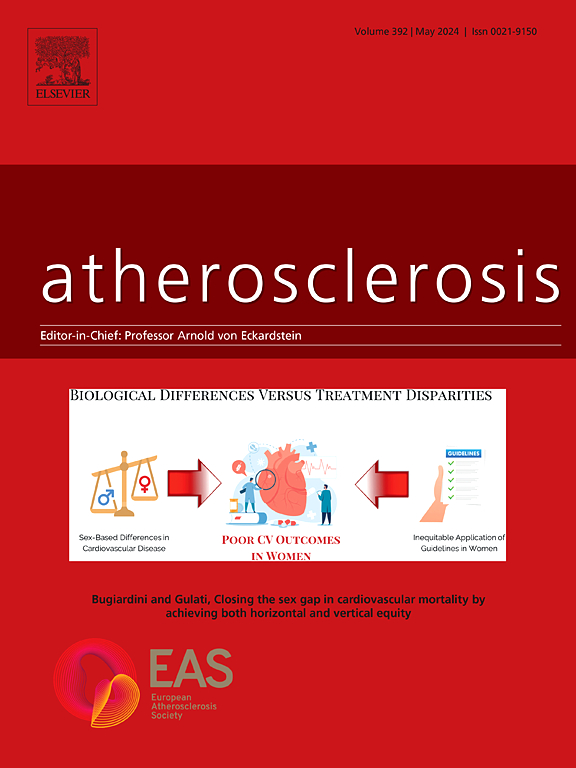揭示GATA4在内皮细胞衰老和动脉粥样硬化发展中的作用
IF 4.9
2区 医学
Q1 CARDIAC & CARDIOVASCULAR SYSTEMS
引用次数: 0
摘要
背景和目的细胞衰老与动脉粥样硬化的发生和发展密切相关。然而,其机制尚不清楚。GATA4是人类成纤维细胞衰老的经典调节因子。本研究旨在确定GATA4在内皮细胞(EC)衰老和动脉粥样硬化发展中的作用及其作用机制。方法用H2O2诱导人脐静脉原代内皮细胞衰老。在老年人(65岁)和老年小鼠(24个月)的动脉组织内皮祖细胞(EPCs)、内皮祖细胞中检测GATA4水平。利用带有EC选择性Tie1启动子的腺相关病毒(一种EC特异性基因转导系统),研究了GATA4在ApoE−/−小鼠EC衰老和动脉粥样硬化发展中的作用。采用RT-qPCR、Western blot、ChIP-PCR、ELISA等方法进一步探讨GATA4在EC衰老和动脉粥样硬化发生中的作用机制。结果H2O2和EPCs诱导的老年EC衰老中gata4蛋白水平升高。此外,老年人和老年小鼠动脉组织ECs中GATA4蛋白水平升高,并与动脉粥样硬化斑块的进展密切相关。敲低GATA4可减少EC衰老、功能障碍和单核细胞粘附。在机制上,我们发现GATA4激活NFκB2转录并诱导衰老相关分泌表型(SASP)表达(IL-6、IL-8、CXCL1、CXCL3、ICAM-1)。ApoE−/−小鼠的体内实验表明,ECs中GATA4过表达导致SASP表达升高、血管衰老、动脉粥样硬化斑块形成和心功能受损。综上所述,我们的研究结果表明,EC GATA4水平升高通过GATA4- nf - κ b2 - sasp途径促进动脉粥样硬化的进展,提示动脉粥样硬化相关疾病的潜在治疗靶点。本文章由计算机程序翻译,如有差异,请以英文原文为准。

Unveiling the role of GATA4 in endothelial cell senescence and atherosclerosis development
Background and aims
Cellular senescence is intimately linked to atherosclerosis development and progression. However, the mechanism is not well known. GATA4 is a classical regulator in human fibroblast senescence. This study aimed to determine the role of GATA4 in endothelial cell (EC) senescence and atherosclerosis development and the mechanisms by which it acts.
Methods
Senescence ECs were induced using H2O2 by isolating human primary umbilical vein ECs from umbilical veins. The level of GATA4 was examined in endothelial progenitor cells (EPCs), ECs of arterial tissue from older individuals (>65 years), and aged mice (>24 months). Adeno-associated virus with EC-selective Tie1 promoter, an EC-specific gene transduction system, was used to explore the role of GATA4 in EC senescence and atherosclerosis development in ApoE−/− mice. RT-qPCR, Western blot, ChIP-PCR, and ELISA were conducted to further explore the mechanism of GATA4 in EC senescence and atherosclerosis development.
Results
GATA4 protein levels are elevated in EC senescence induced by H2O2 and EPCs in older individuals. Additionally, GATA4 protein levels are increased in the ECs of arterial tissue from older individuals and aged mice and are strongly correlated with the progression of atherosclerosis plaques. Knockdown of GATA4 decreased EC senescence, dysfunction, and monocyte adhesion. Mechanistically, we found that GATA4 activates NFκB2 transcription and induces senescence-associated secretory phenotype (SASP) expression (IL-6, IL-8, CXCL1, CXCL3, ICAM-1). In vivo experiments on ApoE−/− mice demonstrated that GATA4 overexpression in ECs contributes to higher SASP expression, vascular senescence, atherosclerotic plaque formation, and impaired cardiac function.
Conclusions
Taken together, our findings indicate that elevated EC GATA4 levels contribute to the progression of atherosclerosis through the GATA4-NFκB2-SASP pathway, suggesting potential therapeutic targets for atherosclerosis-related diseases.
求助全文
通过发布文献求助,成功后即可免费获取论文全文。
去求助
来源期刊

Atherosclerosis
医学-外周血管病
CiteScore
9.80
自引率
3.80%
发文量
1269
审稿时长
36 days
期刊介绍:
Atherosclerosis has an open access mirror journal Atherosclerosis: X, sharing the same aims and scope, editorial team, submission system and rigorous peer review.
Atherosclerosis brings together, from all sources, papers concerned with investigation on atherosclerosis, its risk factors and clinical manifestations. Atherosclerosis covers basic and translational, clinical and population research approaches to arterial and vascular biology and disease, as well as their risk factors including: disturbances of lipid and lipoprotein metabolism, diabetes and hypertension, thrombosis, and inflammation. The Editors are interested in original or review papers dealing with the pathogenesis, environmental, genetic and epigenetic basis, diagnosis or treatment of atherosclerosis and related diseases as well as their risk factors.
 求助内容:
求助内容: 应助结果提醒方式:
应助结果提醒方式:


